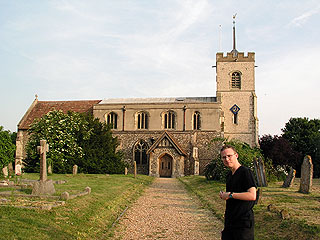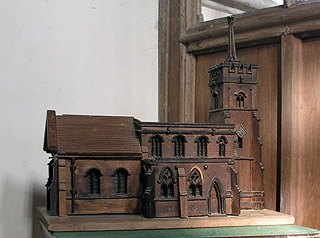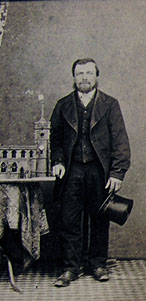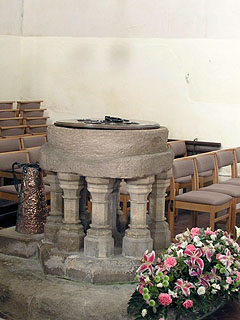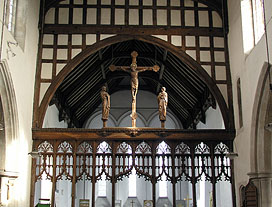I first visited St Laurence's on the last glorious day of May 2003, when Mark and I made a marathon trip visiting thirty churches in a great loop up the Cam valley to Ickleton and Duxford, round north-eastern Hertfordshire and then back up into Cambridgeshire via Litlington and Meldreth. By the time we got to Foxton, it was about seven o' clock. Unsurprisingly, the church was closed, but we'd half expected that. It looked lovely, though - a slender little tower, set off by a very weathered perpendicular clerestory. We smiled at it and drove on, managing to get into one more church (Harston) before returning to Cambridge, just too late for dinner in hall.
The return visit had to wait until October, when I returned to Cambridge after spending the summer at home down in Greenwich. We were driving back up to Cambridge from London, and decided to catch a few churches around the A10 on the way. Remembering the little tower and the clerestory, we went first to Foxton.
It's a very strange shape. [Mark adds: It is indeed, this is made clearer by the delightful model of the church carved by one Charles Impey, a victorian farmworker - there's a slot in the tower roof so that it can, if needed, be used as a money box].
We stepped into a nave which was, with the aisles, wider than long. It was filled with silvery oak benches, made to glow by the golden afternoon light seeping in through the aisle windows and that fine clerestory.
There's nothing particularly unusual about the benches, save their age: they're not decorated, or carved, or anything exciting like that. Still, old oak has its charms. The Books of Common Prayer had obviously succumbed - they stood slightly higgledy-piggledy on the bench closest to the door, huddling together for warmth.
The first thing that caught my eye was the font, which sits at the west end of the nave. It's a peculiar thing - the legs are uninteresting and Victorian, but the bowl is 10th century. It looks like a squashed hat, and is extremely shallow - quite unlike any other font I've seen. I rather liked it, sitting on its legs at a slightly jaunty angle. Next to the font there was a lovely art deco pitcher made of copper, decorated with lots of complex Celtic knot designs.
Moving further west, the woodwork in St Laurence's is particularly fine. The rood screen survives, as does a parclose in the north aisle. This is a particularly delicate 15th century affair, and was originally made to enclose the chapel of St Anne. It is now the Lady Chapel, and on the decorated bracket where St Anne once stood, there is now a reasonably nice modern statue of the Madonna and child. The few remaining fragments of medieval glass have been concentrated in the tops of the chapel windows. In the south aisle, the wall behind the altar has some original red paint remaining. At the west end, there is an early 18th century clock on display, given retirement after some 250 years of service.
The 16th century rood screen itself is more robust than the parclose screen. The Victorians gave it back a rood group. I rather like it when they've done that, although the statues are disappointingly bland - they look rather like oversized versions of the little wooden figures from nativity scenes that they used to have at my primary school, and I find it very difficult imagining anyone treating them as objects of devotion. The chancel arch itself is rather strange, since it's made of timber - indeed, the wall above the arch is a very thin construction of timber and plaster. This may be the site of the '2 pictures of Christ' that Dowsing records in 1643.
The chancel itself is very nice - the roof is arch braced and looks original. Along the wall-plates are little angels, with big pointy wings and little weathered heads, carrying crowns and books and musical instruments. They don't seem to have any structural role, but they're a nice survival. The east end is a 13th century ensemble of three lancet windows, surrounded by delicate moulding. The effect is a little spoiled by the weird Victorian piscina next to the altar, but it's still pretty.
St Lawrence is kept open during the day - just don't turn up too late in the evening!
